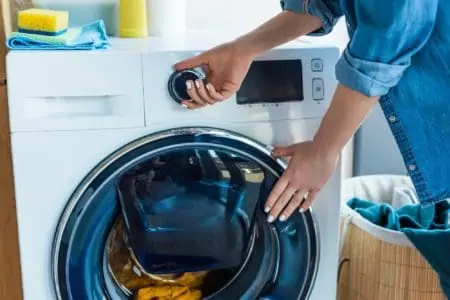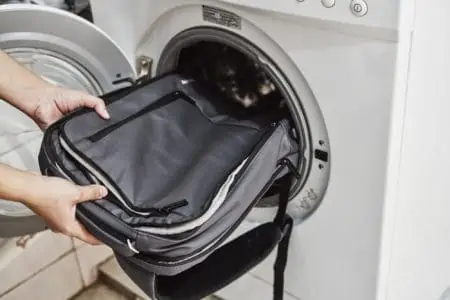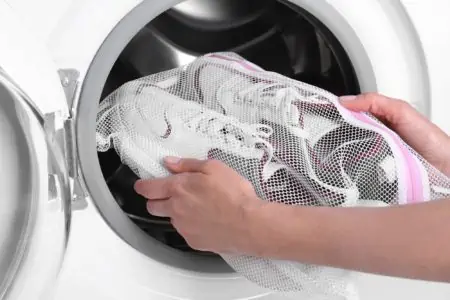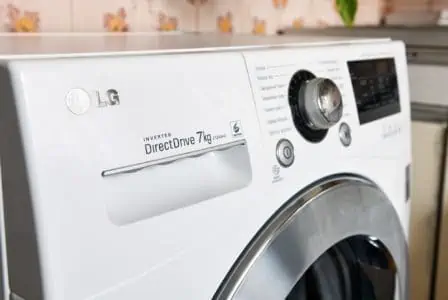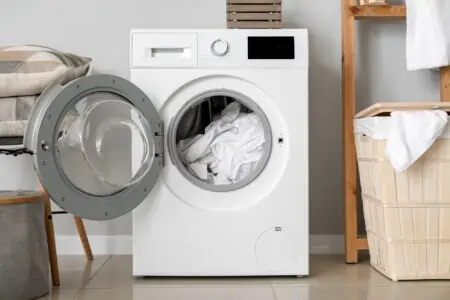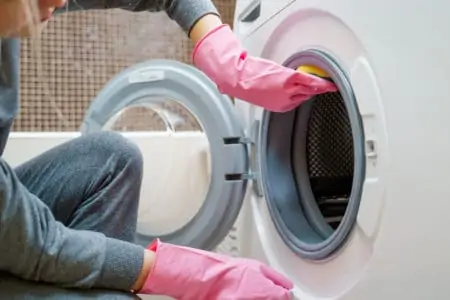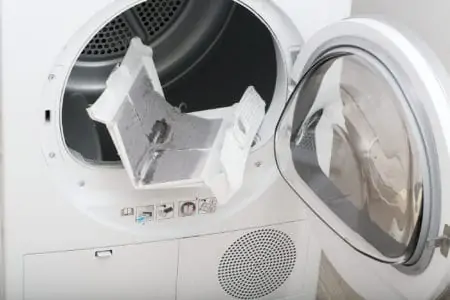Washing machines that suddenly start rattling, shaking, and walking around the laundry room are nerve-wracking. The machine sounds like it’s about to explode or fall apart and you wonder what causes washing machine vibration. Thankfully, the reason is usually a simple one to fix, once you figure out why your washing machine is shaking violently.
So today we’re discussing what causes a vibrating washer and how to fix it.
Key Takeaways
- Check load distribution: Unevenly distributed clothes can cause the washing machine to shake violently, especially with large items like comforters.
- Ensure the washing machine is level: Adjust the washer feet or add floor bracing to make sure the machine is balanced correctly on the floor.
- Use anti-vibration pads or mats: Placing pads or mats under the washer’s feet can help reduce vibrations and stabilize the machine.
- Check and replace shock absorbers or suspension springs: Damaged or worn-out shock absorbers and suspension springs can cause excessive shaking during the spin cycle.
Is It Normal for a Washing Machine to Shake?
Yes, it’s normal for a washing machine to shake a small amount when spinning. However, if your washing machine is shaking violently, thumping, rattling, or walking around the room there’s a problem causing your machine to shake excessively.
Why Is My Washer Shaking Violently?
There are several reasons why your washing machine may be shaking violently. The most common reason is that the clothing is unevenly distributed. This unbalances the machine causing excessive shaking.
Another reason is that the feet are not level which causes an unbalanced washer. Along with feet that are not level, many laundry rooms are in basements that do not have a level floor. The uneven floor will also cause your washer to shake violently.
You don’t have to live with a shaking washing machine. There are several fixes you can try that will stop your washing machine from shaking. Some are quick fixes while others require more effort to implement.
Quick Fixes
There are a few quick fixes that will often fix a shaking washing machine. These include checking the load distribution and making sure that the shipping bolts have been removed. You will also need to ensure that the stacking kit is secured if you have a stackable washer and dryer unit.
Check Load Distribution
If your washer is shaking, the first thing to check is the load distribution. The load can be unevenly distributed in the washer causing the machine to become unbalanced if you’re washing large items such as blankets or comforters. King-size comforters are a common cause of a washing machine shaking excessively.
Your washer may also be unbalanced due to too much laundry being washed at the same time. The solution is to open the lid and redistribute the laundry in the machine. You may need to remove a few items in order to balance your washer properly.
Remove Shipping Bolts
Shipping bolts are hard plastic spaces that clamp the spring suspension system into place. Sometimes they’re not removed during the installation of a new washer. This will cause excessive shaking in your washing machine.
Usually, you’ll use a wrench to loosen each bolt and pull them out of the hole. You may need to cover the holes with plastic covers. Check your user manual for specific instructions for your washing machine.
Check Stacking
Stacked washers and dryers may have a problem with shaking caused by an improperly installed stacking kit.
The stacking kit fits between the washer and dryer and is designed to distribute the weight of the dryer properly on top of the washing machine. It also absorbs the vibrations from both the washer and the dryer while the machines are running. In short, your stacking kit is what makes your washer and dryer one fixed unit that won’t suddenly start wobbling or worse, falling.
If you’re hearing or seeing excessive shaking or loud noises from your washer and dryer, check your stacking kit for loose screws or worn brackets. Use a screwdriver to tighten the screws and replace the worn brackets.
Once the stacking kit is secured, the shaking and noise should stop.
Leveling the Washer
Another common cause for the washing machine shaking excessively is that the machine itself is not level or balanced correctly.
Balance Washing Machine
First, you’ll want to check the balance of your washing machine by placing a level on it. If it isn’t level it may be caused by your washer feet. If they are not adjusted correctly or if the floor itself isn’t level it will cause your machine to be unbalanced. Both of these are easy fixes.
Adjust Washer Feet
The front two feet of most washing machines are self-adjusting. You can raise or lower the legs to balance the machine. Sometimes all four feet are self-adjusting.
You may be able to adjust the feet with your fingers. If not, then have a pair of tongue-in-groove pliers on hand to use.
Before you begin adjusting the washer feet, place a level on your washing machine so you can accurately level the machine. It also helps to have another person help you. One person can lift the washing machine while the other adjusts the feet.
Add Floor Bracing
If your washing machine is in the basement or garage, the floor itself may not be level. While the adjustable washer feet can correct a slightly unlevel floor, you may need a different solution if your slope is excessive.
Build a small platform underneath your machine to level the surface. As it doesn’t need to be a tall platform, you can try laying one or more ⅝ – 1-inch pieces of plywood underneath your washing machine corners until it’s level.
If you prefer a DIY approach, you can use 2x4s and a sheet of plywood to create a custom platform.
Once you’ve built the platform, you can adjust the feet until your washing machine is level.
Other Fixes
If you’ve found that the quick and easy fixes aren’t quite enough to solve your problem of extreme vibration when your washer is spinning, you can also check these other fixes. They may solve the problem for you.
Anti-Vibration Pads
One solution is to add some anti-vibration pads or mats underneath your washing machine. The pads and mats are simply thick pieces of foam or fabric that sit underneath your washer’s feet to reduce the vibrations.
These pads and mats come in different sizes and thicknesses. This way you can find the perfect set for your washer.
The washing machine anti-vibration mat will lay underneath your entire washing machine to reduce the vibrations produced. The washing machine anti-vibration pads rest underneath each foot. This makes it easier to customize the depth of each pad so you can rest assured that your washing machine is level.
Replace Shock Absorbers
Front loading washers have shock absorbers built into the machine to reduce tub movement. These attach to the base frame.
Over time these shock absorbers can become weakened or damaged. This will cause poorly balanced loads to be shaking and banging during the spin cycle. Not only is this annoying, but it can lead to other problems in your washing machine.
If you need to inspect the shock absorbers to make sure they’re not the problem, follow these steps.
- Unplug your machine before you begin working on it.
- Check your washer’s user guide to locate shock absorbers so you know if you need to remove either the front panel or the back panel.
- Remove the correct pane and inspect the shock absorbers. You’re looking for signs of damage that may include broken attachments or leaking fluid.
- If one shock absorber is damaged, you’ll need to go ahead and replace both of them as they wear at roughly the same rate.
If you’re not confident about making this repair yourself, call a professional.
Replace Suspension Springs
The suspension springs are used to suspend the tub assembly from the cabinet, or they’re used to stabilize the tub assembly to the base. This allows them to absorb the vibration from the drum while the machine is spinning.
The suspension springs can become damaged, stretched, or detached which will cause excess noise and shaking.
To inspect the suspension springs, follow these steps.
- Unplug the machine.
- Remove the top panel or the front panel to get access to the springs.
- Now inspect your springs for signs of wear such as stretching or damage. Also, check to be sure that the springs are securely attached at both ends. Remember to be careful as the springs are under tension.
- If you see signs of damage you will need to carefully replace all of the springs at the same time.
Call a professional if you’re unsure about making the repair yourself.
Clean Out the Pump
Excessive vibrations can happen when the drain pump on the washer becomes clogged. If this happens, you can easily clean out the pump.
- Check your user manual to locate the drain pump on your machine and open the small access door. You may need to prop the door open.
- Put a bowl underneath the pump to catch any water that may drain from the pump.
- Turn the filter counterclockwise and pull it out. Clean the filter of all the lint, hair, small objects, and gunk that may be clogging it.
- Check to make sure that no small objects are in the area clogging the hoses.
- Replace the pump.
FAQs
Washing Machine Shakes Violently Spin Cycle
If your top loading or front loading washing machine is rocking violently during the spin cycle, first check to see if the laundry in the machine needs to be redistributed so your machine is balanced correctly. If that doesn’t work, you can try removing some clothing. Finally, check to be sure that your washing machine is level.
